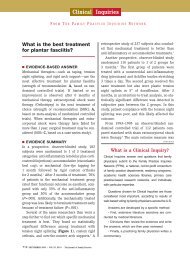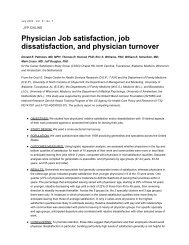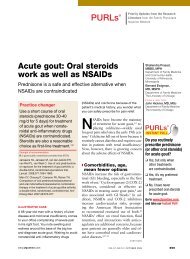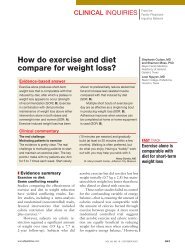Recurrent pleural effusions and a normal cardiac CT
Recurrent pleural effusions and a normal cardiac CT
Recurrent pleural effusions and a normal cardiac CT
You also want an ePaper? Increase the reach of your titles
YUMPU automatically turns print PDFs into web optimized ePapers that Google loves.
OnlIne<br />
ExCLUSIvE<br />
<strong>Recurrent</strong> <strong>pleural</strong> <strong>effusions</strong><br />
<strong>and</strong> a <strong>normal</strong> <strong>cardiac</strong> <strong>CT</strong><br />
Our patient had the classic square root sign typical of<br />
constrictive pericarditis, but contrary to what we would<br />
have expected, his end-diastolic pressures did not equalize.<br />
CASE }An 84-year-old man was admitted to<br />
our family medicine inpatient service with increasing<br />
weakness, fatigue, nausea, jaundice,<br />
<strong>and</strong> anorexia after undergoing thoracentesis<br />
for recurrent large right-sided <strong>pleural</strong> effusion<br />
twice within the past 6 weeks. The patient had<br />
no fever, chills, night sweats, chest pain, or<br />
chronic cough.<br />
his past medical history included coronary<br />
artery disease <strong>and</strong> hyperlipidemia, <strong>and</strong> he had<br />
undergone coronary artery bypass grafting<br />
6 years prior to this admission.<br />
initial vital signs included a blood pressure<br />
of 116/68 mm hg <strong>and</strong> a pulse rate of<br />
78 beats per minute. physical examination<br />
revealed a thin but otherwise active <strong>and</strong><br />
functional man, with the presence<br />
of scleral icterus <strong>and</strong> a 2/6<br />
systolic murmur that was loudest<br />
at the left upper sternal border,<br />
with no pericardial knocks<br />
or rubs. There was no jugular<br />
venous distension. The patient<br />
had decreased breath sounds<br />
at the right base, but no appreciable<br />
rales, rhonchi, or wheezes,<br />
<strong>and</strong> an enlarged liver with an<br />
irregular edge approximately<br />
7 cm below the costal margin.<br />
he had bilateral trace pitting<br />
edema of the lower extremities<br />
<strong>and</strong> an erythematous chronic<br />
venous stasis ulcer on his left<br />
lower leg that was being treated<br />
with sulfamethoxazole <strong>and</strong> trim-<br />
ethoprim <strong>and</strong> rifampin.<br />
z Laboratory findings included a sodium<br />
level of 130 meq/l; creatinine, 1.6 mg/dl; total<br />
bilirubin, 4.2 mg/dl; <strong>and</strong> an international <strong>normal</strong>ized<br />
ratio (inr) of 1.6, with an otherwise<br />
<strong>normal</strong> liver profile. <strong>pleural</strong> fluid was transudative<br />
by light’s criteria, with negative <strong>pleural</strong><br />
fluid cultures.<br />
z A chest x-ray showed right-sided airspace<br />
disease, with an associated small effusion<br />
(FIGURE 1), <strong>and</strong> an electrocardiogram<br />
(eKG) revealed a right axis deviation with<br />
flipped T waves in V3-V6 (FIGURE 2). A computed<br />
tomography (cT) scan of the chest performed<br />
2 months prior to admission revealed<br />
a small right <strong>pleural</strong> effusion, moderate em-<br />
FIGURE 1<br />
X-ray shows right-sided<br />
airspace disease<br />
Stephen J. Warnick Jr, MD;<br />
Jeffrey S. Morgeson, MD<br />
Family Medicine Inpatient<br />
Service, University of Cincinnati<br />
morgesjs@gmail.com<br />
The authors reported no potential<br />
conflict of interest relevant to this<br />
article.<br />
The patient had<br />
decreased breath<br />
sounds at the<br />
right base, but<br />
no appreciable<br />
rales, rhonchi,<br />
or wheezes.<br />
jfponline.com<br />
Vol 59, no 8 | AUGUST 2010 | The joUrnAl of fAmily prAcTice E9<br />
imAGeS coUrTeSy of: STephen j. WArnicK jr, mD
In constrictive<br />
pericarditis,<br />
limitation of the<br />
total volume of<br />
the ventricles<br />
by a rigid<br />
pericardium<br />
causes end-<br />
diastolic<br />
pressures to<br />
equalize. In our<br />
patient, this did<br />
not occur.<br />
E10<br />
FIGURE 2<br />
Right axis deviation with flipped T waves<br />
FIGURE 3<br />
Classic square root sign<br />
physema, <strong>and</strong> <strong>pleural</strong> plaques. A transthoracic<br />
echocardiogram performed a week earlier<br />
was significant for a <strong>normal</strong> ejection fraction<br />
without pericardial thickening, <strong>and</strong> mild dilation<br />
of the left <strong>and</strong> right atria <strong>and</strong> the right<br />
ventricle.<br />
z Our patient had recurrent transudative<br />
<strong>pleural</strong> <strong>effusions</strong> with no history of<br />
congestive heart failure, a <strong>normal</strong> thyroidstimulating<br />
hormone, no signs of nephrotic<br />
syndrome, no risk factors for lung cancer, <strong>and</strong><br />
a presentation that was not consistent with an<br />
acute pulmonary embolus. he had jaundice,<br />
but no risk factors for cirrhosis. A comprehensive<br />
hepatology consult suggested that the<br />
jaundice was associated with recent rifampin<br />
use, along with hepatic congestion likely due<br />
to <strong>cardiac</strong> etiology.<br />
The joUrnAl of fAmily prAcTice | AUGUST 2010 | Vol 59, no 8<br />
z The patient also had a documented<br />
history of constrictive pericarditis. Although<br />
a <strong>cardiac</strong> cT scan 15 months prior to his hospital<br />
admission showed <strong>normal</strong> pericardial<br />
thickness, constrictive pericarditis remained<br />
high on our differential.<br />
To further evaluate the patient’s <strong>cardiac</strong><br />
function, a cardiologist performed a right-<br />
sided <strong>cardiac</strong> catheterization. in constrictive<br />
pericarditis, equalization of end-diastolic pressures<br />
occurs due to limitation of the total volume<br />
of the ventricles by a rigid pericardium. in<br />
our patient, these pressures did not equalize.<br />
his right <strong>and</strong> left ventricular pressure tracings<br />
did, however, have the classic square root sign<br />
often seen in constrictive pericarditis (FIGURE 3).<br />
This “dip <strong>and</strong> plateau” is the result of rapid<br />
filling of the ventricles during early diastole,<br />
with the inflexible pericardium causing an<br />
abrupt halt in ventricular filling. 1<br />
z We considered restrictive cardiomyopathy<br />
in the differential, too, but the signs<br />
<strong>and</strong> symptoms weren’t a perfect fit there, either.<br />
equalization of left <strong>and</strong> right ventricular<br />
end-diastolic pressures in <strong>cardiac</strong> catheterization<br />
is usually not seen in restrictive cardiomyopathy,<br />
but neither is the square-root sign<br />
evident on ventricular pressure monitors. 1<br />
z WHAT IS THE MOST LIKELY<br />
ExPLANATION FOR HIS<br />
CONDITION?
Constrictive pericarditis<br />
On the advice of a cardiologist who specializes<br />
in advanced <strong>cardiac</strong> imaging, our<br />
patient underwent tissue Doppler velocity<br />
echocardiography—a diagnostic test that<br />
provides evidence of a diseased myocardium<br />
(as in restrictive cardiomyopathy), as well as<br />
changes in diastolic blood flow that differentiate<br />
constrictive pericarditis from restrictive<br />
cardiomyopathy. Our patient’s tissue Doppler<br />
velocity echocardiogram revealed a <strong>normal</strong><br />
myocardium with an abrupt cessation of<br />
early left ventricular filling, consistent with<br />
constrictive pericarditis. Along with his clinical<br />
presentation <strong>and</strong> history, this test was<br />
conclusive enough to diagnose constrictive<br />
pericarditis.<br />
Making the diagnosis<br />
in more “typical” cases<br />
Symptoms of constrictive pericarditis include<br />
fluid overload (eg, recurrent <strong>pleural</strong><br />
<strong>effusions</strong> 2-4 ) hepatic dysfunction, <strong>and</strong> peripheral<br />
edema. Studies show that 44% to<br />
54% of patients with constrictive pericarditis<br />
present with <strong>pleural</strong> <strong>effusions</strong>; 5 chest<br />
pain <strong>and</strong> dyspnea are other common symptoms.<br />
6 Past medical history is also impor-<br />
TABLE<br />
Causes of constrictive pericarditis 7<br />
more common<br />
idiopathic<br />
post<strong>cardiac</strong> surgery (coronary artery bypass grafting, valve replacement)<br />
postradiation therapy (eg, for breast cancer, lymphoma)<br />
Viral (pericarditis)<br />
less common<br />
Asbestosis<br />
cancer <strong>and</strong> myeloproliferative disorders<br />
connective tissue disorders (rheumatoid arthritis, systemic<br />
lupus erythematosus)<br />
Adverse drug reaction<br />
infection (tuberculosis, fungal)<br />
Sarcoidosis<br />
Trauma<br />
Uremia<br />
recurrent <strong>pleural</strong> <strong>effusions</strong> <strong>and</strong> <strong>normal</strong> <strong>cardiac</strong> ct<br />
tant, considering the 3 most common risks<br />
for constrictive pericarditis: <strong>cardiac</strong> surgery,<br />
pericarditis, <strong>and</strong> irradiation of the mediastinum<br />
(TABLE). 7<br />
Typical physical exam findings in patients<br />
with constrictive pericarditis include<br />
an elevated jugular venous pressure, third<br />
spacing of fluids, a pericardial knock, <strong>and</strong><br />
Kussmaul’s sign. Our patient had third spacing<br />
of fluids, including mild peripheral edema<br />
<strong>and</strong> the recurrent <strong>effusions</strong> as noted, as<br />
well as signs of hepatic dysfunction that were<br />
initially attributed to his rifampin use. While<br />
these symptoms raise the suspicion of constrictive<br />
pericarditis, none is specific to that<br />
condition alone.<br />
Studies that help in the diagnosis of<br />
constrictive pericarditis include chest xray,<br />
<strong>cardiac</strong> <strong>CT</strong>, echocardiography, <strong>cardiac</strong><br />
magnetic resonance imaging (MRI), <strong>and</strong><br />
<strong>cardiac</strong> catheterization. EKG has no specific<br />
findings, but <strong>cardiac</strong> arrhythmias (eg,<br />
atrial fibrillation) are common. 8 Pericardial<br />
thickening on <strong>cardiac</strong> <strong>CT</strong> scan is a definitive<br />
but not universal finding; in a Mayo Clinic<br />
study, such thickening was not evident in 26<br />
of 143 patients with confirmed constrictive<br />
pericarditis. 8 Cardiac MRI has been shown<br />
Our patient’s<br />
tissue Doppler<br />
velocity<br />
echocardiogram<br />
revealed<br />
a <strong>normal</strong><br />
myocardium<br />
with an abrupt<br />
cessation of<br />
early left<br />
ventricular<br />
filling, consistent<br />
with constrictive<br />
pericarditis.<br />
jfponline.com<br />
Vol 59, no 8 | AUGUST 2010 | The joUrnAl of fAmily prAcTice E11
Pericardial<br />
thickening on<br />
<strong>cardiac</strong> <strong>CT</strong> scan<br />
is a definitive,<br />
but not<br />
universal<br />
finding.<br />
E12<br />
to have 88% sensitivity <strong>and</strong> 100% specificity,<br />
9 but will miss up to 18% of patients with<br />
constrictive pericarditis. 8<br />
z Differentiating between restriction<br />
<strong>and</strong> constriction. It can be difficult to distinguish<br />
between constrictive pericarditis <strong>and</strong><br />
restrictive cardiomyopathy. Although these<br />
conditions can present in a similar manner,<br />
they require different modes of treatment.<br />
Laboratory testing, <strong>cardiac</strong> catheterization,<br />
<strong>and</strong> tissue Doppler velocity echocardiography<br />
(which we relied on) can help to distinguish<br />
between them.<br />
Pericardiectomy is the treatment<br />
of choice<br />
Pericardiectomy, the optimal treatment for<br />
most patients with constrictive pericarditis,<br />
carries a 30-day perioperative mortality<br />
of approximately 6%. 5,7 Patients with minimal<br />
symptoms can be monitored for up to<br />
2 months, but only 17% of cases are self-<br />
limited. 6 Patients with end-stage disease or<br />
those who have radiation-induced constrictive<br />
pericarditis experience poor surgical<br />
outcomes, <strong>and</strong> may be better served by medical<br />
management. 7<br />
references<br />
1. Maisch B, Seferovic PM, Ristic AD, et al. Guidelines on the<br />
diagnosis <strong>and</strong> management of pericardial diseases executive<br />
summary; The Task force on the diagnosis <strong>and</strong> management<br />
of pericardial diseases of the European Society of Cardiology.<br />
Eur Heart J. 2004;25:587-610.<br />
2. Akhter MW, Nuño IN, Rahimtoola SH. Constrictive pericarditis<br />
masquerading as chronic idiopathic <strong>pleural</strong> effusion: importance<br />
of physical examination. Am J Med. 2006;119:e1-e4.<br />
3. Ramar K, Daniels CA. Constrictive pericarditis presenting as<br />
unexplained dyspnea with recurrent <strong>pleural</strong> effusion. Respir<br />
Care. 2008;53:912-915.<br />
4. Sadikot RT, Fredi JL, Light RW. A 43-year-old man with a large<br />
recurrent right-sided <strong>pleural</strong> effusion. Diagnosis: constrictive<br />
pericarditis. Chest. 2000;117:1191-1194.<br />
5. Bertog SC, Thambidorai SK, Parakh K, et al. Constrictive peri-<br />
The joUrnAl of fAmily prAcTice | AUGUST 2010 | Vol 59, no 8<br />
In light of our patient’s excellent baseline<br />
functional status, clinical presentation,<br />
<strong>and</strong> Doppler test results, a cardiothoracic<br />
surgeon performed a pericardiectomy. His<br />
symptoms improved postoperatively, <strong>and</strong><br />
he has had no further <strong>pleural</strong> <strong>effusions</strong>. The<br />
patient’s fatigue, anorexia, weight loss, <strong>and</strong><br />
dyspnea fully resolved, as well. JFP<br />
CORRESPONDENCE<br />
jeffrey S. morgeson, mD; 2123 Auburn Avenue, 340 moB,<br />
cincinnati, oh 45219; morgesjs@gmail.com<br />
practice pointers<br />
} include constrictive pericarditis in the differential<br />
diagnosis of patients with recurrent <strong>pleural</strong><br />
<strong>effusions</strong>, an important presenting symptom in<br />
44% to 54% of patients with this condition.<br />
} consider multiple testing modalities to arrive<br />
at a diagnosis of constrictive pericarditis, including<br />
<strong>cardiac</strong> cT or mri, tissue Doppler echocardiography,<br />
<strong>and</strong> <strong>cardiac</strong> catheterization.<br />
} Do not rule out constrictive pericarditis if<br />
pericardial thickening is not found on <strong>cardiac</strong><br />
cT scan; in 1 study, this finding was not present<br />
in 18% of patients with a confirmed diagnosis.<br />
carditis: etiology <strong>and</strong> cause-specific survival after pericardiectomy.<br />
J Am Coll Cardiol. 2004;43:1445-1452.<br />
6. Haley JH, Tajik AJ, Danielson GK, et al. Transient constrictive<br />
pericarditis: causes <strong>and</strong> natural history. J Am Coll Cardiol.<br />
2004;43:271-275.<br />
7. Ling LH, Oh JK, Schaff HV, et al. Constrictive pericarditis<br />
in the modern era: evolving clinical spectrum <strong>and</strong> impact<br />
on outcome after pericardiectomy. Circulation. 1999;100:<br />
1380-1386.<br />
8. Talreja DP, Edwards WD, Danielson GK, et al. Constrictive<br />
pericarditis in 26 patients with histologically <strong>normal</strong> pericardial<br />
thickness. Circulation. 2003;108:1852-1857.<br />
9. Masui T, Finck S, Higgins CB. Constrictive pericarditis <strong>and</strong><br />
restrictive cardiomyopathy: evaluation with MR imaging.<br />
Radiology. 1992;182:369-373.








